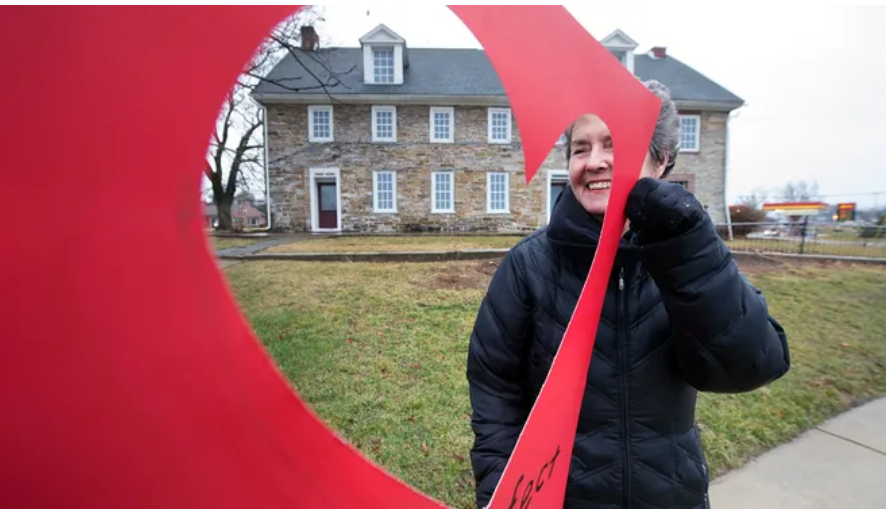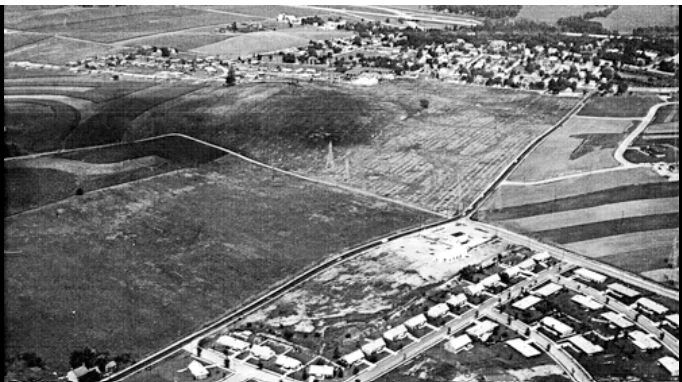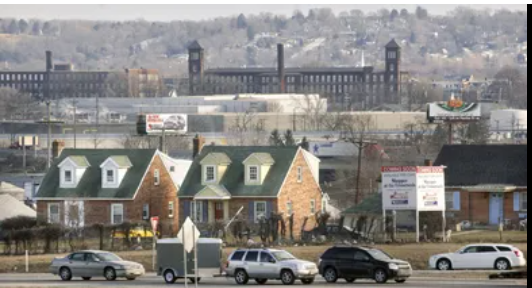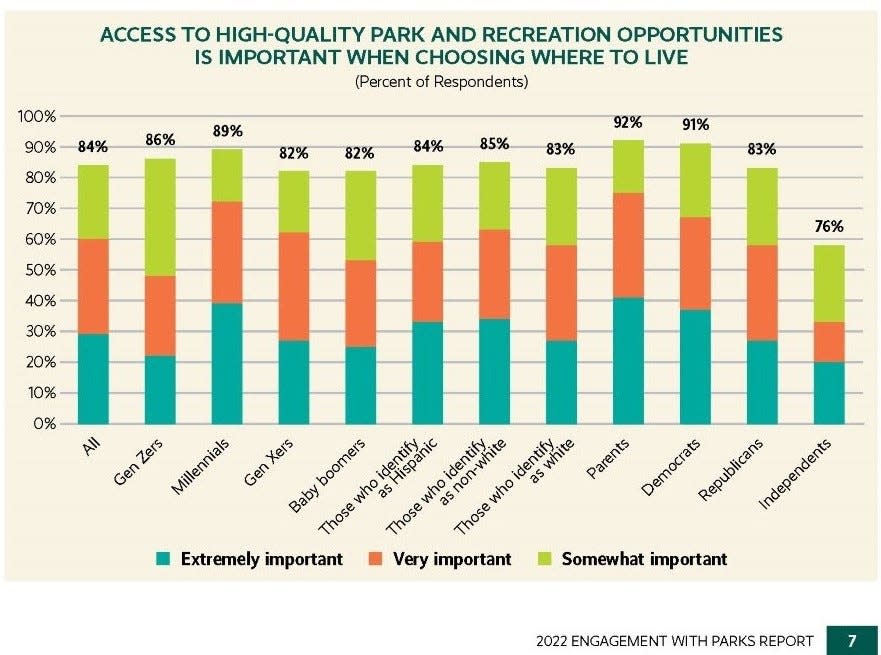York County sprawl threatens historic landmark, quality of life
(Editor’s note: In a column last week about the Yorktowne Hotel, I wrote about how the symbolic heart of York County moved about 1970 from the pedestrian-friendly Continental Square in York to the cloverleaf, designed for motorists, where the Route 30 bypass crosses under Interstate 83 in Manchester Township. This week, I tie this car culture to two land-use controversies roiling York County.)
There’s a picture showing Loucks Road running through the farm fields north of York not that long ago. It had the familiar look of a two-lane country road.
That would change in the 1960s, fostered by a major 1950s event: Interstate 83.
As York County’s census numbers — particularly its automobile-dependent suburban population — grew in the post-World War II years, the idea of a north/south bypass around York dovetailed with the Eisenhower administration’s plans for a national interstate road defense system.

So Interstate 83 was dedicated in 1959, replacing the Susquehanna Trail — George Street in York — as York County’s major north and south route.
Soon, transportation planners looked for an east and west bypass to service the growing suburbs and to alleviate congestion in the city. They eyed quiet Loucks Road as part of the solution and work began. This new four-lane road, opened in sections starting in 1969, met up with the interstate in a cloverleaf north of York.
This moment about 50 years ago provided an exclamation point in York County’s transportation story. Motorists had the ability to move freely to all major compass points and avoid the congestion of the downtown.
Or was it actually a question mark in our transportation story?
This road system created issues in the use of land that continue to this day, as with a warehouse eyeing green space formerly connected with Prospect Hill Cemetery and Rutter’s apparent plans to demolish a circa 1750 stone landmark in Spring Grove.

York County crossroads
Look at a map of York County in 1770, and you’ll see roads running in and out of York a mere 21 years after its founding. A few years later, the famed Mason and Dixon surveying team devoted 65 miles of its line to York County. So the county became a point where North met south, accessible to the Southern port of Baltimore and Northern harbor of Philadelphia.
One of those roads running through York, the Great Wagon Road, brought settlers on their way to the Shenandoah Valley, eastern Tennessee and North Carolina.
Ever since, transportation would be part of the county’s brand, and the Interstate 83/Route 30 three-leaf cloverleaf would be its modern 20th-century logo.
So with this transportation pedigree, industrial parks and warehouses popped up along 83. And then Route 30. And proximity to that 83/30 intersection became coveted property.
More on the Hoke House:Historic house in Spring Grove facing possible demolition after efforts to save it
More:Rutter's won't renew agreement to save historic Hoke House in Spring Grove
Logistics trumped making things. A warehouse replaced the old York/Shipley boiler plant along North Hills Road. And then the iconic Harley-Davidson plant — formerly the manufacturing site of York Safe & Lock-made Navy ack-ack guns — was replaced by a neighboring state-of-the-art Harley assembly plant. And a warehouse went in where the demolished Harley plant once stood.
Any open land near this intersection became game for development. The old Central York High School football field in North York is under consideration for conversion to a 21st-century sports complex, akin to Lancaster County’s Spooky Nook.
And so it was only time until another open piece of land near Prospect Hill Cemetery would come under development pressure from a proposed warehouse. Inch & Co., a relative newcomer to York County and the prospective North York sports complex developer, has made the warehouse proposal.
A sports complex on a former football field in a developed area makes sense. A warehouse on green space next to a cemetery does not.

Building near cloverleaf
That cloverleaf’s connection with the endangered circa 1750 Hoke House in Spring Grove might not be as obvious.
Rutter’s has been part of the York County scene since 1747 with its dairying epicenter in Manchester Township several hay fields from the cloverleaf.
For years, its dairy delivered milk to homes.
But then growing mobility meant people did not have to depend on milk deliveries at home. That spelled the demise of the Rutter’s milkman, who made his last delivery in the York area in the early 1990s.
Rutter’s convenience stores also were more, well, convenient, selling gas to a growing number of motorists, replacing full-service gas stations. Rutter’s was the local entry into what became a dogfight among stores. It established stores from Hellam Township to West Manchester Township along Route 30 — and even one along a remaining link of the township’s Loucks Road.
Its stores popped up at most exits on Interstate 83, including two near the key North George Street exit, the exit just north of the cloverleaf.
With York County’s geographical position, it was inevitable that convenience store competitors — Lancaster County’s Turkey Hill and Baltimore-based Royal Farms as two examples — would attempt to bite into transportation-rich York County.
Then there’s Altoona-based Sheetz and its construction about a decade ago of a store about as close to the cloverleaf as you could get. It’s in a confusing commercial area of hotels and eateries that replaced a residential area favored by workers of the factories that were being replaced by logistics and transportation services.
So Sheetz sits in the southeast corner of York County’s new town square, across the way from Rutter’s original farm. And then in the past year comes the news that Wawa, the Philadelphia-based convenience store giant, is entering the York County convenience store fray with stores in Hanover and Dover Township.
Rutter’s is likely looking at all its properties, including its Spring Grove store, to ensure that they’re all contributing in this battle. When in a dogfight against the likes of Wawa, one wonders if it makes sense to kick some solid stone doghouse – the Hoke House.

Retaining, attractive talent
What’s the use of these stories from history? Are we just admiring problems caused by car culture and sprawl?
Developers and township officials need to ensure they aren’t eating the seed corn as the economic development climate is changing.
In a late 2022 presentation to a Pennsylvania legislative parks and recreation caucus, the York County Economic Alliance’s Silas Chamberlin noted the growing support from economic development professionals for developing the outdoor economy.
“Talent attraction will be the competitive issue of the next decade,” Chamberlin wrote in his presentation. “Regions that offer high-quality of life, access to open space and walkable, historic communities will succeed.”
He provided three bullet points:
Access to bike/walking paths is consistently a top three consideration for homebuyers across all demographics.
Half of recent college graduates say “place” is more important than the job in searching for a career.
About three-quarters of corporate executives consider quality-of-life features — trails and parks — on par in importance as energy costs, market access and the corporate tax rate.
Many York County residents get this, and they’re ahead of many developers and township officials in that regard. Government officials can fuel smart growth with their hand on the throttle of zoning ordinances and the like.
That’s why when there are threats to open space, as near Prospect Hill Cemetery, and historic buildings, as with the Hoke House, people light up social media and form friends’ groups.
And government officials who covet the tax money from sprawl-producing projects should get the idea that the tax money put into municipal treasuries will leak from the bottom if people and companies go elsewhere or never come here in the first place. They notice when the bulldozer has knocked down landmarks and shoved aside green turf.

Change in York County
Stand on the hill above the old Howard Johnson’s Motor Lodge overlooking the I-83/Route 30 crossroads and look to the south.
You’ll see the dual towers of the old York Silk Manufacturing Co. and its single smokestack. The former maker of silk pajamas is now an apartment complex. The service sector fills the old maker’s space built more than a century ago.
You’ll see the Sheetz store accompanied by hotels and a rental car agency to service motorists traveling on paved-over fields in Manchester Township.
And you’ll see a Texas-based Cheddar’s restaurant. Another chain, you might think. Actually, consider this: A restaurant that suggests cheese in the county’s congested symbolic center might be helpful. It reminds us of the agricultural roots from which York County grew, the quality of life at risk and the green space we must continue to fight for.
Sources: YDR files, Stephen H. Smith’s Yorks Past blog, James McClure’s “Never to be Forgotten.”

Upcoming presentations
I’m presenting on these topics in OLLI @ Penn State York’s spring term: “A Walk through the Park: York City Parks, That Is,” “Major Crimes and Misdemeanors in York County's Past” and “The York Daily Record and Gathering York County News Since 1796.
Details: Details: https://olli.psu.edu/york/
Jim McClure is a retired editor of the York Daily Record and has authored or co-authored nine books on York County history. Reach him at jimmcclure21@outlook.com.
This article originally appeared on York Daily Record: York County sprawl threatens historic landmark, plus quality of life

